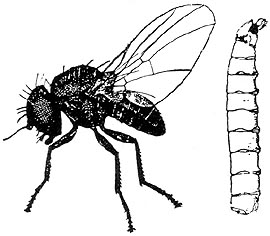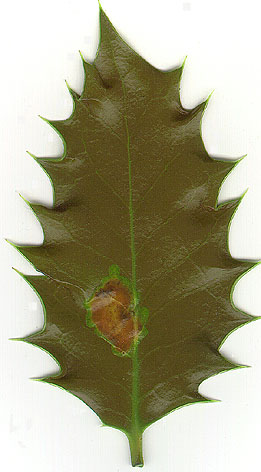
about 3 mm
BUG OF THE MONTH: December 1994
Holly Leaf Miners:
Order Diptera, family Agromyzidae
Phytomyza ilicis and P. ilicicola
Copyright © 1994 by Louise Kulzer
This article originally appeared in Scarabogram, Dec. 1994, New Series No. 176, pp. 2-4.

|
| Typical agromyzid adult and larva; about 3 mm |
Holly leaf miners are not typically met with enthusiasm, especially during the holiday season, as they make unsightly blotches on the leaves of holly. However, like many pests, they have an interesting life story enhanced by fascinating interactions between insect, host, and parasite. In the Pacific Northwest, the most common holly is the Oregon or European Holly, Ilex aquifolium. The American Holly, Ilex opaca, is native to the eastern U.S. and occurs in Seattle, along with numerous cultivated varieties, as an ornamental plant. The Oregon and American hollies each have their own leaf miner species! In the Seattle area, both species occur: Phytomyza ilicis, the Oregon Holly Leaf Miner, and Phytomyza ilicicola, the American Holly Leaf Miner (Collman 1972). Lucky us.
[According to Cole (1969), adults of P. ilicis, an introduced species, differ from P. ilicicola in "the half-yellow frons and 6-8 (not 4-5) rows of acrostical bristles" (median dorsal bristles on thorax).]
As an adult, the holly leaf miner is a small black fly which emerges in May, when holly has several new, soft leaves on which the adults feed and oviposit. In fact, adults can only feed at this time, the older hardened holly leaves being a bit too tough for the wee delicate flies. Eggs are laid singly on the under-surface of leaves and hatch in about 10 days. The larvae then enter the leaf through the midrib, mining the palisade parenchyma ["sandwich filling" of the leaf]. Larvae spend the winter feeding within the leaf, then pupate in spring. Larvae occupy only one leaf, pupating in the same leaf they enter as first instar larvae. In fact, some would look on mined leaves as akin to islands in evolutionary theory (Janzen 1968).

|
| Wing and head of Phytomyza adult |
Typically there is a single larva per leaf, but sometimes there is more than one. Larvae are apparently unable to cross each other's mines, and they are also reluctant to reverse direction. Hence, they can come to a dead end within the leaf and run out of food. Leaves with multiple leaf miners often have larvae with decreased weights and increased mortality due to this intra-specific competition (Potter 1985).

|
| Ilex aquifolium leaf with Phytomyza ilicis mine (no exit hole). |
The mine pattern itself identifies which of the two leaf miners is present. P. ilicis, the Oregon holly leaf miner, creates yellow-brown blotches or blisters on the upper leaf surface. The American holly leaf miner, P. ilicicola, produces long winding mines.
How does the holly react to all this? There is some evidence that mined leaves age faster, turn yellow, and fall off the tree before their unmined counterparts (Kahn & Cornell 1989). Although a broadleaved evergreen, holly loses some of its leaves in spring, when leaf miners are in their pupal stages. Some studies show that fallen leaves have a higher incidence of miners than unfallen leaves, and also have correspondingly higher pupal mortalities. However, there is less predation by hymenopteran parasites on fallen leaves. Hence the net benefit of the holly's leaf-dropping strategy is somewhat dubious. In case you're wondering how this bit of information could possibly be discerned, it just so happens that holly leaf miners exit the leaf leaving a larger "D-shaped" hole whereas parasites exit the leaf with a smaller circular hole.
An interesting finding about parasites: Chrysocharis gemma (Eulophidae, Hymenoptera), one of the main parasites of the Oregon Holly Leaf Miner P. ilicis, causes a density dependent death rate in the larval population. This is significant because theory has it that a parasite that does this can be a viable biocontrol agent (Heads & Lawton 1983). In fact, C. gemma has reportedly been used in British Columbia as an effective biocontrol agent for P. ilicis (Clausen 1978). Theory triumphs again!
Applying this new-found knowledge to my Ballard holly, an Ilex aquifolium plaguing the side of my driveway, I found interesting but somewhat equivocal results. Out of a total of 75 leaves with mines, 7 of them had two mines (none had more than two), for a total of 82 mines. All seemed fairly blotchy, although 9 were winding enough for me to wonder if they might be P. ilicicola (I doubt it, however).

|
| Exit holes. Left, parasite. Center, uncertain. Right, Phytomyza (mm scale) |
I also looked at exit holes. Out of the 82 mines, only 23% had D-shaped or oblong exit holes, whereas 39% had what I thought were circular exit holes. And I couldn't find any exit holes at all on 35% of the mines. Of the remaining 3%, 2% were torn open and the remaining 1% was due to rounding errors. If I interpreted shapes correctly, I had lots of predation (circular exit holes) but still a lot of currently active mines (I'm guessing most of the mines without exit holes are currently active). So much for effective parasitism, huh? However, I don't know which of several hymenopteran parasites was active in my miner population, nor do I know if the predation was density-dependent. I think I need another study (Maybe I've been working for government too long?)
A last tidbit for bird lovers: small tree-foraging birds feed on larval leaf miners by tearing open the mines. They do not, however, feed on pupae. In Europe, blue tits are known to feed on holly leaf miners. In the Pacific Northwest, chickadees and bushtits probably perform a similar role. Guess we could use more bushtits in Ballard!
Next time you see blotches on holly leaves, you can ask yourself which leaf miner it is (large and blotchy: P. ilicis; long and winding: P. ilicicola). Remember also, that ugly leaf is the whole world to a leaf miner, and potential food to bird and parasitic wasp alike. Deck the Halls, every leaf miner is an island!
References
Clausen, C.P. 1978. Introduced parasites and predators of arthropod pests and weeds: a world review. USDA Handbook No. 480, pp. 313-315.
Cole, F.R. 1969. The flies of western North America. University of California Press, 693 pp.
Collman, S.J. 1972. Insect pests of ornamental trees and shrubs of the University of Washington arboretum. M.S. Thesis, Univ. of Wash., Seattle.
Heads, P.A. & J.H. Lawton. 1983. Studies on the natural enemy complex of the holly leaf-miner: the effects of scale on the detection of aggregative responses and implications for biological control. Oikos 40: 267-276.
Janzen, D.H. 1968. Host plants as islands in evolutionary and contemporary time. American Naturalist 104: 501-528.
Kahn, D.M. and H.V. Cornell. 1989. Leaf miners, early leaf abscission, and parasitoids: a tritrophic interaction. Ecology 70(5): 1219-1226.
Potter, D. 1985. Population regulation of the native holly leaf miner, Phytomyza ilicicola Loew (Diptera: Agromyzidae), on American holly. Oecologia 66: 499-505.
This page last updated 26 July, 2005